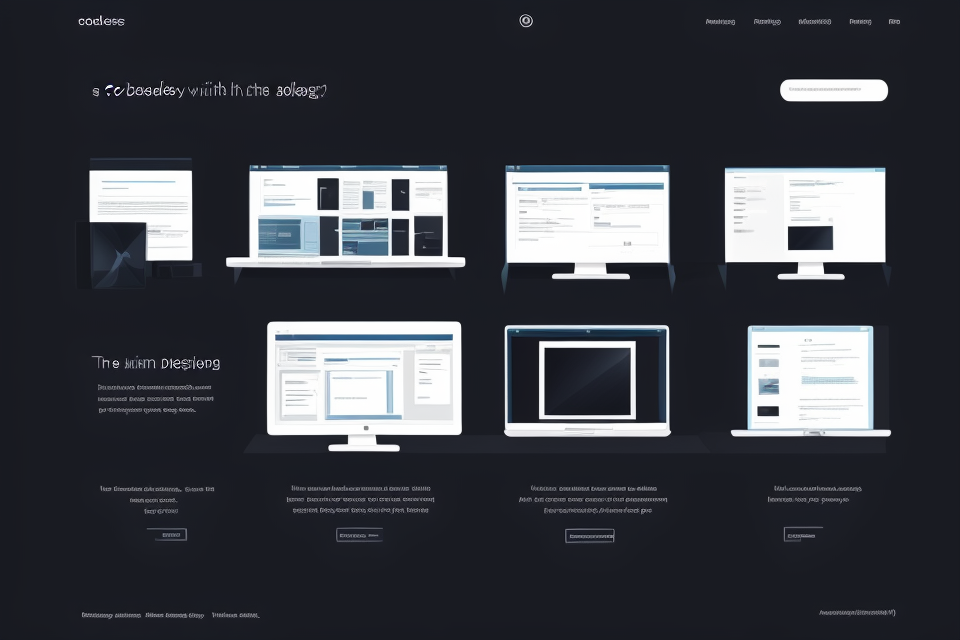The world of technology is constantly evolving, and with it, the demand for different types of developers. One question that has been circulating in the industry is whether front-end developers are becoming obsolete. With the rise of new technologies and the changing landscape of web development, it’s important to explore whether the front-end development industry is fading away or if it’s still a viable career path. In this article, we’ll delve into the current state of front-end development and discuss the factors that are shaping its future. So, is the front-end development industry on its last legs, or is it still a thriving field? Let’s find out.
No, the front-end development industry is not fading away. In fact, it is continuing to grow and evolve as technology advances. With the increasing use of the internet and mobile devices, the demand for skilled front-end developers is on the rise. Front-end development involves creating the user interface and user experience of websites and applications, and it is a crucial aspect of the software development process. As more businesses move online, the need for well-designed and functional websites and applications will only continue to increase. Therefore, the front-end development industry is expected to remain strong in the coming years.
The Rise of Front-End Development
The Evolution of Web Development
From Static to Dynamic Websites
In the early days of the internet, websites were primarily static pages with minimal interactivity. They were built using basic HTML and CSS, and users could only view and read the content without being able to interact with it. However, as the internet became more popular and the demand for more interactive websites grew, web developers began to explore new technologies that would allow them to create more dynamic and engaging experiences for users.
The Emergence of JavaScript and Frameworks
JavaScript, a programming language that was originally developed for use in web browsers, emerged as a key tool for creating dynamic websites. With JavaScript, developers could add interactivity and animation to web pages, creating a more engaging user experience. In addition, JavaScript frameworks like jQuery and AngularJS emerged, providing developers with pre-built libraries of code that could be used to build more complex and dynamic websites more quickly and easily.
As JavaScript and frameworks became more popular, web development shifted from being primarily focused on HTML and CSS to being focused on building interactive, dynamic user experiences. This shift led to the emergence of new job roles like front-end developer, which focused on building the user-facing parts of websites using JavaScript and other front-end technologies.
Overall, the evolution of web development has been driven by the need to create more engaging and interactive user experiences. As the internet has become more popular and competition for users has increased, web developers have had to adapt and evolve their skills to meet the changing demands of the industry.
The Growing Demand for Front-End Developers
In recent years, the demand for front-end developers has increased significantly. This is due to the growing need for web-based applications and the increasing complexity of these applications. Front-end developers are responsible for creating the user interface and user experience of websites and web applications, making their skills highly sought after by companies of all sizes.
Job Opportunities and Salaries
According to recent job market trends, the demand for front-end developers is expected to continue to grow in the coming years. This is reflected in the numerous job opportunities available in this field, with many companies actively seeking out candidates with the necessary skills and experience. In addition, the salaries for front-end developers are often quite competitive, with many earning six-figure salaries.
Skills Required for Front-End Development
To be successful as a front-end developer, one must possess a wide range of skills. These include proficiency in programming languages such as HTML, CSS, and JavaScript, as well as a strong understanding of user experience design and user interface design. Additionally, front-end developers must be able to work collaboratively with other members of a development team, as well as with clients and stakeholders. With the increasing complexity of web-based applications, front-end developers must also be able to keep up with the latest technological advancements and be able to adapt to new tools and frameworks as they emerge.
The Future of Front-End Development
The Impact of New Technologies
The rapid advancement of technology has had a profound impact on the front-end development industry. New technologies are constantly emerging, changing the way developers work and the skills they need to have. Here are some of the most significant new technologies that are shaping the future of front-end development:
Progressive Web Apps (PWAs)
Progressive Web Apps (PWAs) are web applications that have the look and feel of native mobile apps. They offer a seamless user experience, can be installed on a device’s home screen, and load quickly even with poor internet connections. PWAs are built using standard web technologies such as HTML, CSS, and JavaScript, making them accessible to developers with existing front-end skills. As PWAs continue to gain popularity, they are likely to become a dominant form of web application, potentially reducing the demand for traditional web development skills.
Single-Page Applications (SPAs)
Single-Page Applications (SPAs) are web applications that load all content on a single page, eliminating the need for page reloads. This provides a fast and seamless user experience, making SPAs a popular choice for e-commerce and other high-traffic websites. Developers with skills in JavaScript frameworks such as React or Angular are well-positioned to take advantage of the growing demand for SPAs. However, the trend towards SPAs may also reduce the demand for traditional web development skills, such as HTML and CSS.
Headless Front-End Frameworks
Headless front-end frameworks are front-end frameworks that can be used without a prescribed structure or architecture. This allows developers to create custom, tailored solutions for their clients, rather than relying on pre-built templates. Headless front-end frameworks require developers to have strong JavaScript skills and a deep understanding of the framework’s underlying architecture. As more businesses seek custom, unique solutions, the demand for headless front-end frameworks is likely to increase, creating new opportunities for developers with these skills.
In conclusion, the impact of new technologies on the front-end development industry is significant. As PWAs, SPAs, and headless front-end frameworks continue to gain popularity, developers will need to adapt to these new technologies in order to stay relevant in the industry. While some traditional skills may become less in demand, the need for skilled front-end developers is likely to remain strong, particularly for those with expertise in emerging technologies.
The Shift in Demand for Skills
As the front-end development industry continues to evolve, so does the demand for specific skills and expertise. In the coming years, certain skills will become more critical for front-end developers to master, while others may become less important.
Mobile-First Design
Mobile-first design has been a significant trend in recent years, and it is expected to continue to be a critical skill for front-end developers. As more and more people access the internet primarily through their mobile devices, the need for responsive and mobile-friendly websites and applications will only continue to grow.
Front-end developers must be proficient in designing for various screen sizes, adapting to different screen resolutions, and ensuring that their websites and applications are optimized for mobile devices. This includes knowledge of responsive design, touch-friendly interfaces, and the ability to design for various mobile platforms, such as iOS and Android.
Focus on Accessibility and Performance
Accessibility and performance are also becoming increasingly important in the front-end development industry. With the rise of assistive technologies and the need for inclusive design, front-end developers must be able to create websites and applications that are accessible to users with disabilities.
In addition to accessibility, performance is also critical. As the internet becomes more saturated with content, users expect fast-loading websites and applications. Front-end developers must be able to optimize their code for performance, including knowledge of image optimization, minification, and caching.
Emphasis on User Experience (UX)
Finally, user experience (UX) is becoming an increasingly important aspect of front-end development. As more and more websites and applications compete for users’ attention, the user experience can be a critical factor in differentiating one product from another.
Front-end developers must be able to create intuitive and user-friendly interfaces that provide a seamless experience for users. This includes knowledge of user research, usability testing, and user-centered design principles.
Overall, the shift in demand for skills in the front-end development industry is towards mobile-first design, accessibility and performance, and user experience. As the industry continues to evolve, front-end developers must be able to adapt to these changes and develop the skills necessary to meet the demands of the market.
The Challenges Facing Front-End Development
Keeping Up with Rapidly Evolving Technologies
In the fast-paced world of technology, front-end development is constantly evolving, with new technologies and frameworks emerging regularly. This rapid evolution poses significant challenges for front-end developers, who must keep up with the latest trends and tools in order to remain competitive in the job market.
Balancing Old and New Technologies
One of the main challenges facing front-end developers is balancing the need to learn new technologies with the need to maintain and update existing projects. Many organizations have legacy systems that are still in use, and front-end developers must often work with a combination of old and new technologies. This requires a deep understanding of both the older technologies and the newer ones, as well as the ability to integrate them seamlessly.
The Role of Continuous Learning
Given the rapidly changing nature of front-end development, continuous learning is essential for developers who want to stay ahead of the curve. This means not only keeping up with the latest technologies and frameworks, but also learning new programming languages and development tools as they become available. For many front-end developers, this requires a significant investment of time and effort, as well as a willingness to embrace lifelong learning.
Another important aspect of continuous learning is staying up-to-date with industry trends and best practices. This involves attending conferences and workshops, reading industry publications, and participating in online communities and forums. By staying connected with other developers and industry experts, front-end developers can gain valuable insights into the latest trends and developments, and can apply this knowledge to their own work.
Overall, the challenges facing front-end development are significant, but they are also an opportunity for developers to hone their skills and stay ahead of the curve. By embracing continuous learning and staying up-to-date with the latest technologies and trends, front-end developers can remain competitive in a rapidly evolving industry.
Maintaining a Work-Life Balance
The Pressure to Meet Deadlines
As the demand for websites and applications that are visually appealing and user-friendly continues to grow, front-end developers are under immense pressure to meet tight deadlines. Clients and employers often expect quick turnaround times, which can lead to developers working long hours to meet these expectations. This constant push to deliver work quickly can take a toll on a developer’s personal life, leading to missed family dinners, skipped weekend plans, and limited downtime.
Dealing with Burnout and Stress
In addition to the pressure to meet deadlines, front-end developers also face the challenge of dealing with burnout and stress. The demanding nature of the job can lead to a sense of exhaustion and overwhelm, as developers work to create complex designs and code. This can lead to decreased productivity, increased errors, and a higher likelihood of leaving the industry altogether. Furthermore, the constant need to stay up-to-date with the latest technologies and best practices can add to the stress and anxiety of front-end developers, who may feel overwhelmed by the pace of change in the industry.
Despite these challenges, many front-end developers continue to thrive in their careers, finding ways to balance their work and personal lives and to manage stress and burnout. Some have found success by setting clear boundaries and schedules, prioritizing self-care and relaxation, and seeking support from colleagues and mentors. Others have found ways to incorporate their passions and hobbies into their work, making the job more fulfilling and enjoyable. However, for others, the challenges of front-end development may prove too much, leading them to seek out new opportunities or to leave the industry altogether.
Overcoming the Shortage of Skilled Developers
The shortage of skilled developers is a significant challenge facing the front-end development industry. With the rapid pace of technological advancements, there is a growing demand for front-end developers who possess the necessary skills to build cutting-edge web applications. However, the pool of skilled developers is limited, and the competition for their services is intense.
The Importance of Training and Education
To overcome the shortage of skilled developers, it is essential to invest in training and education programs that equip individuals with the necessary skills to succeed in the industry. This includes programs that focus on front-end development, as well as programs that teach a combination of front-end and back-end development. By providing access to these programs, it is possible to increase the pool of skilled developers and meet the growing demand for their services.
Encouraging Diversity in the Industry
Another approach to overcoming the shortage of skilled developers is to encourage diversity in the industry. This includes attracting individuals from diverse backgrounds, such as women and minorities, who are often underrepresented in the tech industry. By creating a more inclusive environment, it is possible to tap into a wider pool of talent and address the shortage of skilled developers. Additionally, fostering diversity in the industry can help to address the gender and ethnic disparities that currently exist in the tech industry.
The Future of Front-End Development
The Importance of Adapting to Change
The future of front-end development is constantly evolving, and it is crucial for professionals in this field to adapt to new technologies and trends. This means staying up-to-date with the latest developments in web design and programming languages, as well as understanding the changing needs and preferences of users.
Embracing New Technologies and Trends
One of the most significant challenges facing front-end developers is the rapid pace of technological change. New web technologies and programming languages are emerging all the time, and it is essential for professionals in this field to keep up with these changes. This includes learning new tools and frameworks, as well as staying up-to-date with the latest design trends and user experience best practices.
The Need for Continuous Growth and Learning
In order to succeed in the future of front-end development, professionals must be committed to continuous growth and learning. This means investing in ongoing education and training, as well as seeking out new opportunities to develop their skills and knowledge. Whether it’s attending industry conferences, participating in online communities, or pursuing additional certifications and degrees, the key to success in this field is a willingness to embrace new challenges and continue learning throughout one’s career.
FAQs
1. Is the front-end development industry dying?
No, the front-end development industry is not dying. In fact, it is growing and evolving rapidly. With the increasing use of the internet and mobile devices, the demand for front-end developers is on the rise. Companies need skilled front-end developers to create user-friendly and visually appealing websites and applications that can be accessed on a variety of devices.
2. Are front-end development skills becoming obsolete?
No, front-end development skills are not becoming obsolete. While new technologies and frameworks are emerging, the fundamental skills of front-end development, such as HTML, CSS, and JavaScript, are still essential. In fact, mastering these skills can open up a wide range of career opportunities for front-end developers.
3. Is there a future in front-end development?
Yes, there is a bright future in front-end development. As technology continues to advance, the demand for skilled front-end developers will only increase. Front-end developers play a crucial role in creating engaging and user-friendly experiences for users, and their skills are in high demand across a variety of industries.
4. Is it worth learning front-end development?
Yes, it is definitely worth learning front-end development. With the increasing demand for skilled front-end developers, learning front-end development can open up a wide range of career opportunities. Additionally, front-end development is a highly transferable skill, meaning that it can be applied to a variety of industries and job roles.
5. Is front-end development difficult to learn?
Front-end development can be challenging to learn, especially for those who are new to coding. However, with dedication and practice, anyone can learn the basics of front-end development. There are many resources available online, such as tutorials, courses, and forums, that can help individuals learn front-end development at their own pace.



